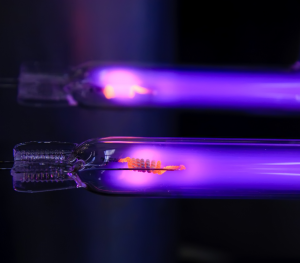
Ultraviolet light, or UV light, is a type of electromagnetic radiation. The electromagnetic spectrum consists of different regions with various wavelengths, including radio waves, microwaves, infrared (IR), visible light, ultraviolet (UV), X-rays, and gamma-rays.
UV light is present in sunlight and makes up around 10% of the light that eventually comes through the atmosphere to earth.
UV light can also be produced by electric arcs and specialized lights for various practical human applications.
To understand how UV light works, we must first understand how photons work.
Light And Photons
All light is made from tiny particles called photons. Photons vibrate back and forth and create a wave in space.
The faster they vibrate, the less the distance between these waves. This wavelength is the way to differentiate between different forms of light, such as UV light.
Long waves have slower vibrating photons and also have less energy. Conversely, short waves have quicker vibrating photons and have more energy.
The way that different wavelengths of light affect people and the environment depends on the molecular structure of the matter and the way that light is reflected and absorbed.
Visible light
Visible light affects our eyes, making us able to see it. The wavelength is between 400 and 700 nanometers, which is the perfect range to stimulate the light receptors in our retina.
Infrared light
With a more extended range of 700 to 1 000 000 nanometers, the human eye cannot see infrared light. It can, however, be felt as warmth as this range is perfect for the heat receptors in the human body.
Ultraviolet light
Ultraviolet light has a shorter range than both UV and visible light, which cannot be seen nor felt.
However, it does have incredibly high levels of electromagnetic energy due to the short waves, which means that it can have various significant effects on matter and humans.
There are three types of UV light, each with protons that vibrate at different speeds.
- UV-A light: 315 to 400 nanometers and photons that vibrate slightly faster than visible light
- UV-B light: 280 to 315 nanometers with photons that vibrate faster than UV-A light.
- UV-C light: 100 to 280 nanometers with the fastest proton vibration and the most energy of all UV light.
Germicidal UV-C Light
With the most energy of all UV light variations, UV-C light is intense and can cause damage to the cells of tiny bacterial microorganisms. As such, it has been used to sterilize and kill bacteria for over a hundred years.
It is used extensively in the scientific and medical fields to clean areas and equipment but is also available as an air purification system for home use.
Volatile organic compounds (VOCs), harmful chemicals in household cleaning products, mildew, spores, and bacterial and viral elements, present in the air we breathe and are particularly dangerous in home environments.
These can cause foul odors and severe allergic reactions and make us sick.
UV-light air purification systems that incorporate UV-C light are highly effective in eliminating these airborne threats. Click here to view the FDA’s information regarding the benefits and effectiveness of UV light.
These systems sanitize the air that comes into contact with it and all HVAC system components, leaving you with the type of air you want – Pure, fresh, and harmless.
Find out more about purifying your household with the power of UV-C today!
